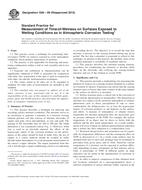Potrebujeme váš súhlas na využitie jednotlivých dát, aby sa vám okrem iného mohli ukazovať informácie týkajúce sa vašich záujmov. Súhlas udelíte kliknutím na tlačidlo „OK“.
ASTM G84-89(2012)
Standard Practice for Measurement of Time-of-Wetness on Surfaces Exposed to Wetting Conditions as in Atmospheric Corrosion Testing
Automaticky preložený názov:
Štandardná prax pre meranie času-of-vlhkosť na povrchu na pomočovanie podmienok ako v atmosférickej korózii testovaní
NORMA vydaná dňa 1.1.2012
Informácie o norme:
Označenie normy: ASTM G84-89(2012)
Poznámka: NEPLATNÁ
Dátum vydania normy: 1.1.2012
Kód tovaru: NS-57845
Počet strán: 7
Približná hmotnosť: 21 g (0.05 libier)
Krajina: Americká technická norma
Kategória: Technické normy ASTM
Kategórie - podobné normy:
Anotácia textu normy ASTM G84-89(2012) :
Keywords:
electronic circuitry, installation and maintenance, moisture sensing, monitoring techniques, site calibration, time of wetness, Aluminum coatings, Atmospheric corrosion analysis, Atmospheric wet deposition (AWD), Condensation, Cyclic corrosion testing, Hot-dip (galvanized) coatings, Moisture analysis, Nonferrous metals/alloys, Surface analysis--metals/alloys, Time of wetness, Wetness, ICS Number Code 17.040.20 (Properties of surfaces)
Doplňujúce informácie
| Significance and Use |
|
This practice provides a methodology for measuring the duration of wetness on a sensing element mounted on a surface in a location of interest. Experience has shown that the sensing element reacts to factors that cause wetness in the same manner as the surface on which it is mounted. Surface moisture plays a critical role in the corrosion of metals and the deterioration of nonmetallics. The deposition of moisture on a surface can be caused by atmospheric or climatic phenomena such as direct precipitation of rain or snow, condensation, the deliquescence (or at least the hygroscopic nature) of corrosion products or salt deposits on the surface, and others. A measure of atmospheric or climatic factors responsible for moisture deposition does not necessarily give an accurate indication of the TOW. For example, the surface temperature of an object may be above or below both the ambient and the dew point temperatures. As a result condensation will occur without an ambient meteorological indication that a surface has been subjected to a condensation cycle. Structural design factors and orientation can be responsible for temperature differences and the consequent effect on TOW as discussed in 4.2. As a result, some surfaces may be shielded from rain or snow fall; drainage may be facilitated or prevented from given areas, and so forth. Therefore various components of a structure can be expected to perform differently depending on mass, orientation, air flow patterns, and so forth. A knowledge of TOW at different points on large structures can be useful in the interpretation of corrosion or other testing results. In order to improve comparison of data obtained from test locations separated on a macrogeographical basis, a uniform orientation of sensor elements boldly exposed in the direction of the prevailing wind, at an angle of 30° above the horizontal is recommended. Elevation of the sensor above ground level should be recorded. Although this method does not develop relationships between TOW and levels of ambient relative humidity (RH), long term studies have been carried out to show that the TOW experienced annually by panels exposed under standard conditions is equivalent to the cumulative time the RH is above a given threshold value. This time value varies with location and with other factors. Probability curves have been developed for top and bottom surfaces of a standard panel at one location which show the probable times that a surface will be wet as a percentage of the cumulative time the relative humidity is at specific levels. If needed, it should be possible to develop similar relationships to deal with other exposure conditions. |
| 1. Scope |
|
1.1 This practice covers a technique for monitoring time-of-wetness (TOW) on surfaces exposed to cyclic atmospheric conditions which produce depositions of moisture. 1.2 The practice is also applicable for detecting and monitoring condensation within a wall or roof assembly and in test apparatus. 1.3 Exposure site calibration or characterization can be significantly enhanced if TOW is measured for comparison with other sites, particularly if this data is used in conjunction with other site-specific instrumentation techniques. 1.4 The values stated in SI units are to be regarded as standard. No other units of measurement are included in this standard. 1.5 This standard does not purport to address all of the safety concerns, if any, associated with its use. It is the responsibility of the user of this standard to establish appropriate safety and health practices and determine the applicability of regulatory limitations prior to use. |




 Cookies
Cookies
